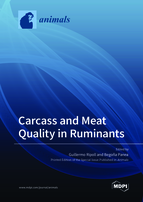Carcass and Meat Quality in Ruminants
A special issue of Animals (ISSN 2076-2615). This special issue belongs to the section "Animal System and Management".
Deadline for manuscript submissions: closed (30 May 2022) | Viewed by 26374
Special Issue Editors
Interests: animal science; animal production; meat quality; meat products; acceptability of meat and meat products; the shelf-life of meat and meat products; ruminant production systems; ultrasound; immunocastration; animal science; cattle; consumers; near-infrared spectroscopy (NIRS); carcass quality
Special Issues, Collections and Topics in MDPI journals
2. Agrifood Institute of Aragon-IA2 (CITA-Zaragoza University), Avda. Montañana 930, 50059 Zaragoza, Spain
Interests: animal science; animal production; meat quality; meat products; meat science; shelf-life; color; texture; sensory analysis; consumer tests
Special Issues, Collections and Topics in MDPI journals
Special Issue Information
Dear Colleagues,
Ruminant production systems are very important in many areas of the world and a key aspect of the economy and culture. Small ruminants, such as goats and sheep, play an important role in low-income areas because they can graze marginal pastures that other species cannot use. Moreover, these systems fix the population to unfavorable rural areas and even can prevent forest fires.
Food quality is a complex term that includes, in addition to safety, such intrinsic characteristics as appearance, color, texture, and flavor, which are modified by both pre- and post-mortem factors. For this Special Issue, we are interested in studies on any of these factors or preservation methods for improving the quality and shelf-life of meat. We also welcome manuscripts on carcass development, quality, and valorization. We invite the submission of original research and review articles; however, manuscripts related to extrinsic characteristics (origin, quality labels, price, etc.) of a carcass or meat do not fall into the scope of this Special Issue. We are also interested in applied research and the interaction between pre- and post-mortem factors, e.g., nutrition and preservation methods for improving the quality and conservation of a carcass and meat, and methods for assessing carcass quality (ultrasound, image analysis, etc.).
Dr. Guillermo Ripoll
Dr. Begoña Panea
Guest Editors
Manuscript Submission Information
Manuscripts should be submitted online at www.mdpi.com by registering and logging in to this website. Once you are registered, click here to go to the submission form. Manuscripts can be submitted until the deadline. All submissions that pass pre-check are peer-reviewed. Accepted papers will be published continuously in the journal (as soon as accepted) and will be listed together on the special issue website. Research articles, review articles as well as short communications are invited. For planned papers, a title and short abstract (about 100 words) can be sent to the Editorial Office for announcement on this website.
Submitted manuscripts should not have been published previously, nor be under consideration for publication elsewhere (except conference proceedings papers). All manuscripts are thoroughly refereed through a single-blind peer-review process. A guide for authors and other relevant information for submission of manuscripts is available on the Instructions for Authors page. Animals is an international peer-reviewed open access semimonthly journal published by MDPI.
Please visit the Instructions for Authors page before submitting a manuscript. The Article Processing Charge (APC) for publication in this open access journal is 2400 CHF (Swiss Francs). Submitted papers should be well formatted and use good English. Authors may use MDPI's English editing service prior to publication or during author revisions.
Keywords
- lamb
- beef
- veal
- goat
- color
- texture
- nutrition
- management
- shelf-life
- pre-mortem
- post-mortem
- meat proximal composition
- carcass characteristics
- morphometric measurements.








